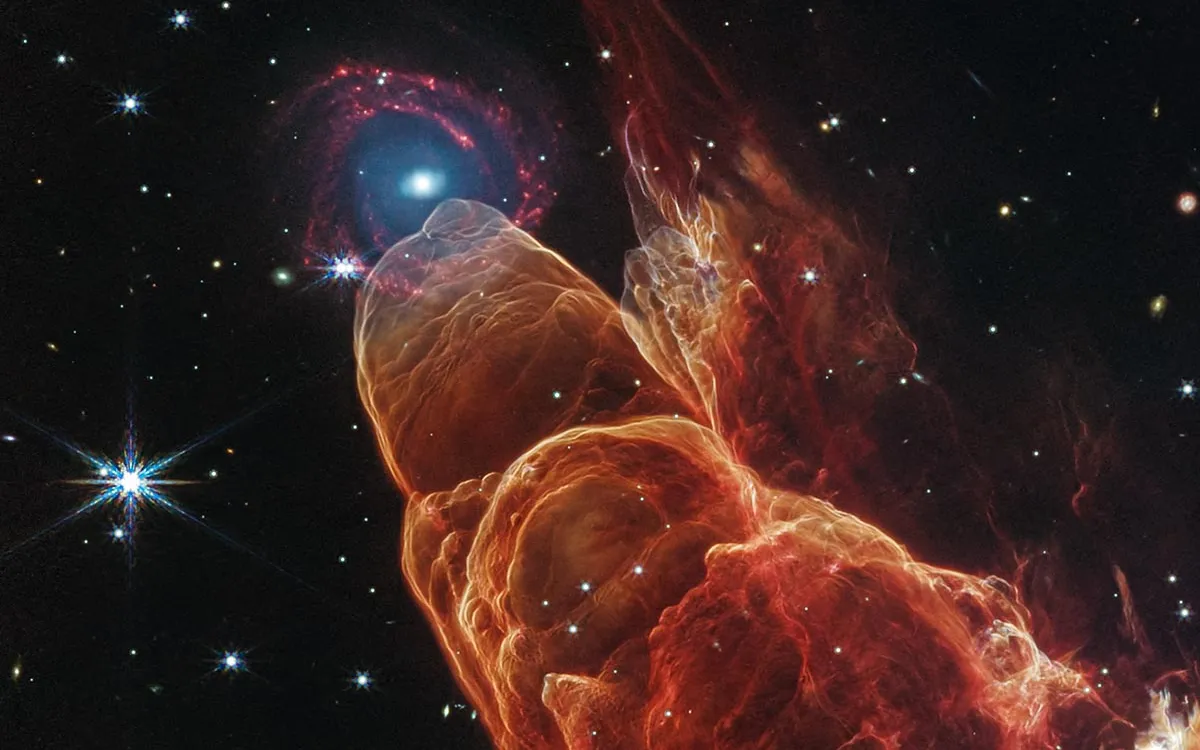
The James Webb Space Telescope (JWST) has recently provided astronomers with a breathtaking view of a rare cosmic phenomenon. This observation reveals a chance alignment between a nearby protostellar outflow, designated as Herbig-Haro 49/50, and a distant spiral galaxy. The intricate details captured in this infrared composite image allow scientists to delve into the early stages of star formation and the dynamics of cosmic structures.
When we observe the universe, we perceive a three-dimensional space projected onto a two-dimensional image. This means that celestial objects that appear close together in the sky might actually be separated by immense distances, lacking any real physical connection. The JWST’s latest findings showcase this phenomenon, as Herbig-Haro 49/50—a protostellar outflow—is seen in alignment with a distant spiral galaxy. This remarkable observation emphasizes the importance of advanced technologies in astronomy.
Herbig-Haro objects are fascinating astronomical formations created when high-speed jets from forming stars collide with surrounding material. These jets can extend for light-years, generating shock waves that heat the gas involved. As this gas cools, it emits light across both visible and infrared wavelengths, making it an ideal subject for study with infrared telescopes like the JWST. The latest image of Herbig-Haro 49/50, often referred to as the “Cosmic Tornado,” is a visual treat for the eyes, showcasing a frothy outflow from a young star in combination with a colorful spiral galaxy.
In 2006, the Spitzer Space Telescope observed this same region, leading scientists to nickname HH 49/50 the “Cosmic Tornado” due to its striking twisted shape. However, the identity of the bright, fuzzy feature at the tip of the outflow remained uncertain until now. Thanks to Webb’s superior resolution, astronomers can now discern fine details in the shocked gas and confirm that this fuzzy feature is indeed a distant spiral galaxy, surrounded by a backdrop of even more remote galaxies.
Herbig-Haro 49/50 is located in the Chamaeleon I Cloud complex, one of the closest regions of active star formation within our Milky Way. This area is home to numerous low-mass stars that are similar to our Sun, suggesting a resemblance to the environment where our own star was born. Observations indicate that the HH 49/50 outflow is moving away from us at impressive speeds of 60-190 miles per second (100-300 kilometers per second). This outflow is just one component of a larger protostellar outflow that is being studied in detail.
The observations made by the JWST's Near-Infrared Camera (NIRCam) and Mid-Infrared Instrument (MIRI) have provided invaluable insights into the composition of the outflow. The glowing hydrogen molecules, carbon monoxide, and energized dust grains are clearly represented in orange and red hues. These detailed observations allow astronomers to model the jet's properties and understand its impact on the surrounding material. The unique arc-shaped features within HH 49/50 resemble the wake of a speeding boat, pointing back to the source of the outflow.
Scientists suspect that a protostar known as Cederblad 110 IRS4 may be responsible for the jet activity observed in HH 49/50. Located approximately 1.5 light-years away from the outflow, this Class I protostar is in a crucial phase of gaining mass. It typically features a discernible disk of material that continues to fall onto it, providing a fascinating avenue for further study.
The detailed images captured by Webb reveal more than just the outflow; they also provide insights into unusual features like an outcrop at the top right of the main outflow. This anomaly could represent another chance superposition of a different outflow or a result of the main outflow fragmenting. Such findings highlight the complexities of cosmic events and the ongoing mysteries of star formation.
At the tip of HH 49/50 lies a distant, face-on spiral galaxy, characterized by a prominent central bulge indicating the presence of older stars. This central bulge exhibits hints of “side lobes,” suggesting that it may be a barred-spiral galaxy. Additionally, the reddish clumps within its spiral arms signify warm dust and regions of star formation. The galaxy's structure is reminiscent of other nearby galaxies studied by Webb as part of the PHANGS program.
This remarkable observation by the James Webb Space Telescope captures two seemingly unconnected objects in a rare cosmic alignment. Over thousands of years, the edge of Herbig-Haro 49/50 will move outward, eventually obscuring the distant spiral galaxy from view. Situated about 625 light-years from Earth in the constellation Chamaeleon, this observation underscores the JWST's pivotal role as the leading space science observatory. With its capabilities, the JWST continues to unravel the mysteries of our universe, from the inner workings of our solar system to the study of exoplanets and the origins of galaxies and stars.